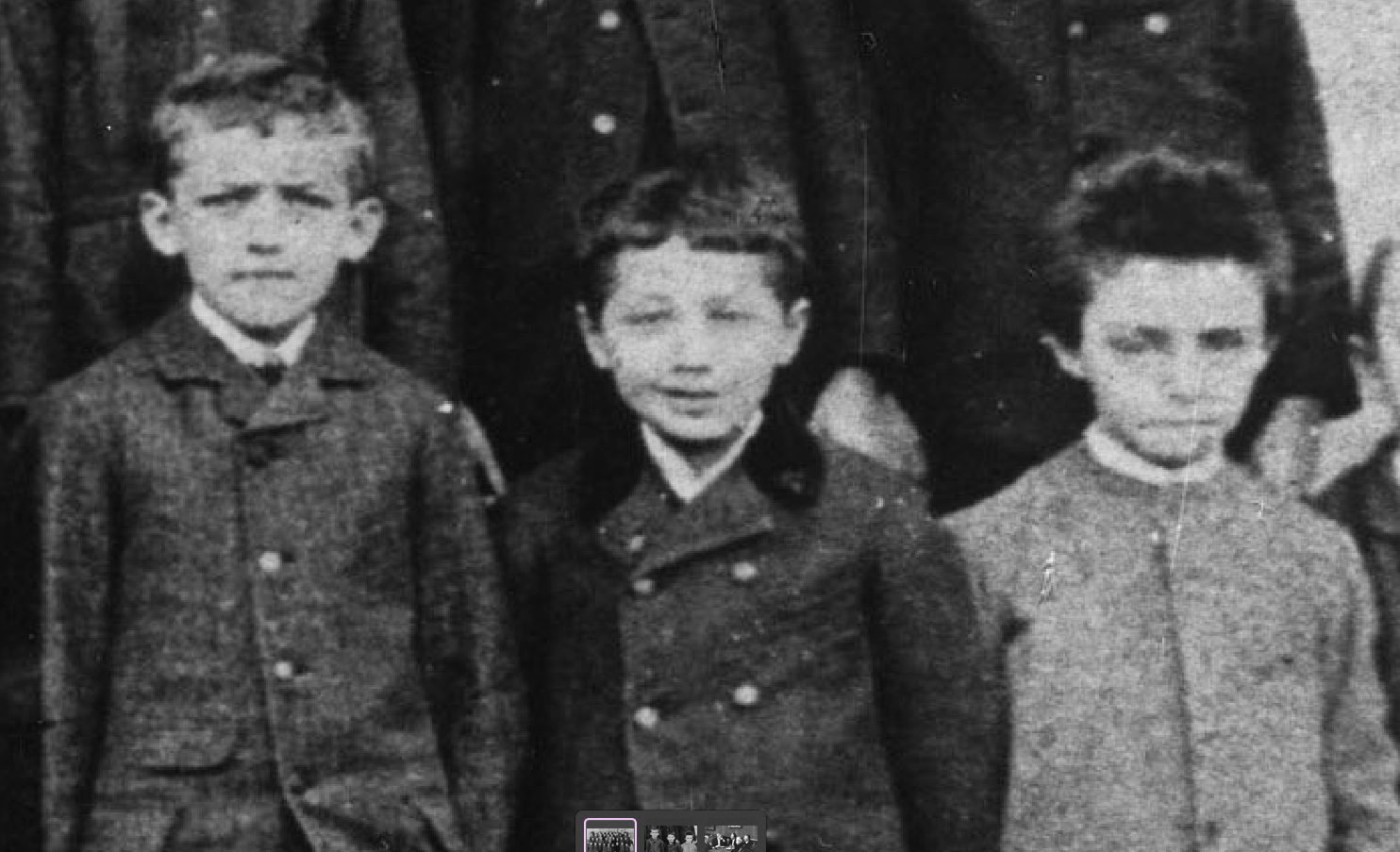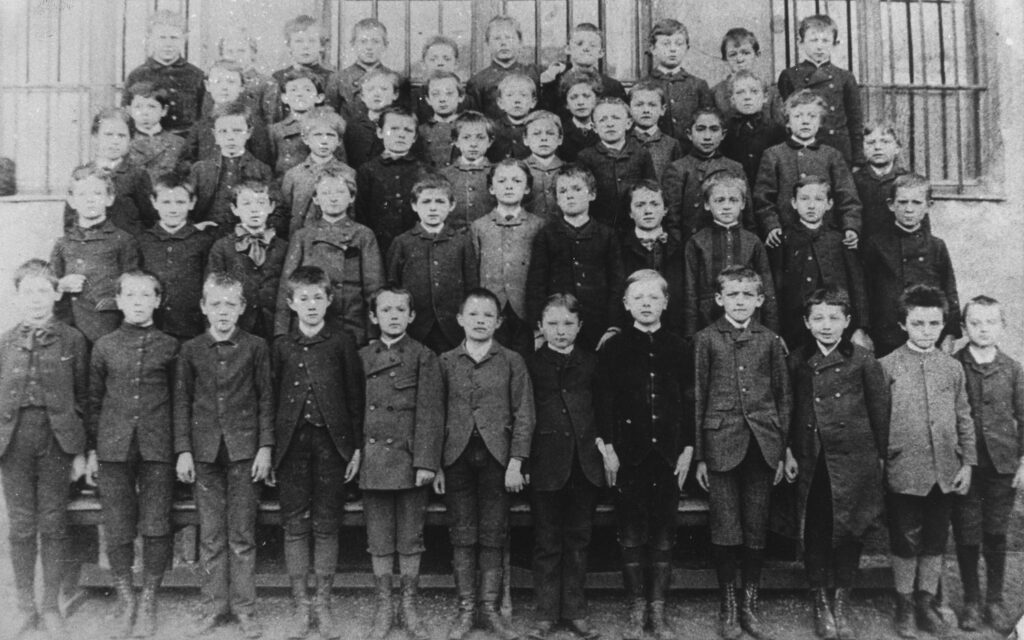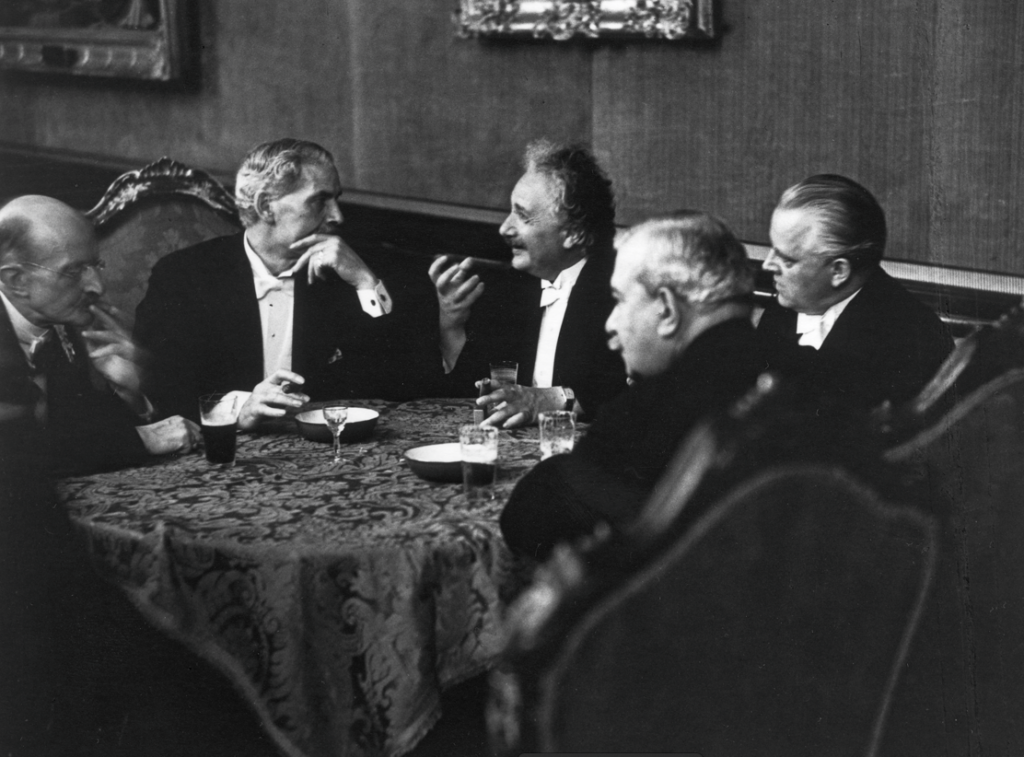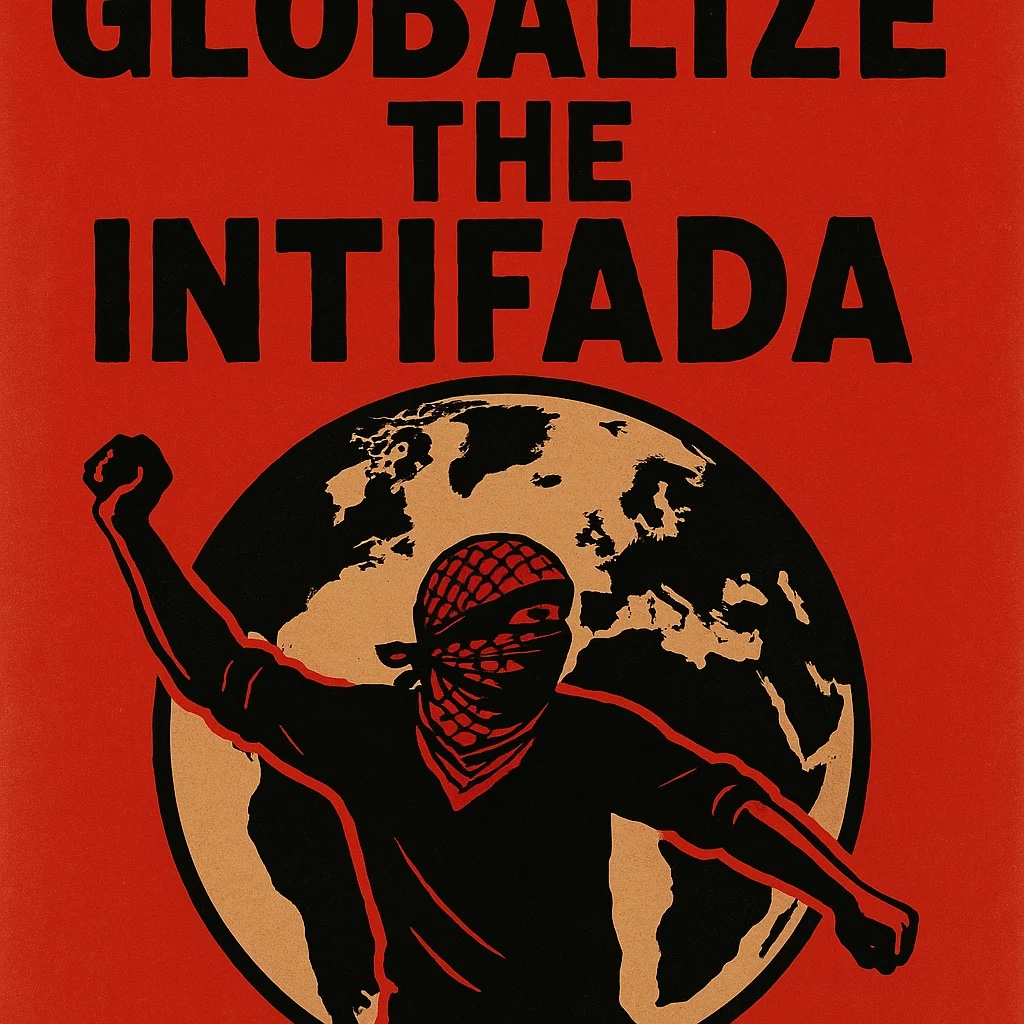Features
Einstein’s Smile: A Tale of Two Pictures

By DAVID TOPPER In my previous story in the Jewish Post & News, “Einstein & Johanna: A True Tale of Tragic Comedy,’’ I began by saying that I first heard the name “Einstein” when I was around the age of 10.

So let me begin this story when Albert himself was about that same age, and he had his class photo taken on the steps of his school. This picture is one of the earliest pictures we have of him – and it’s one of my favourites. It shows his all-boys class of 52 students lined-up in five rows. Einstein is in the front row, the third from the right, and clearly one of the smallest in the group.
The unique and utterly fascinating thing about this picture is this simple fact: all the other boys are looking grimly at the camera, while little Albert is the only one with a smile on his face. Look closely: all 51 others, with hands at their sides, appear stern, anxious, intimidated, sulky, or scared; Einstein, with hands behind his back, has a cute, little, slightly impish smirk on his face – unquestionably, a look that any parent would love. Just compare the detailed picture of him with the boys to his immediate sides : the contrast, indeed, is at once stunning and amusing.
Right here, in this astounding image (a mere class photo) is the visual manifestation of the laid-back contrarian that he would become throughout his life. In this one picture, knowing what I know about him, his whole life almost flashes forward before me. So, here, I wish to share a piece of this story with you.
As reported by those who knew him, Einstein was modest and unpretentious, without an iota of conceit or arrogance, treating all people in the same manner, independently of class or rank. He spoke the same way to a president as to a janitor. He also had a hearty laugh, with a child-like twinkle in his eye. OK, all this may be a bit of an exaggeration (sounding more like Santa Claus), but variations of these traits are persistently repeated among those who knew him and reminisce about his personality. He really was a down-to-earth guy. For example, he refused to travel first-class. Even when sent first-class tickets, he sat in third-class, driving the fastidious ticket-takers crazy.
I have a second picture to talk about. But before that, I want to see what else there is about his life that I can read into his class picture. What do we know about his early life that might help us? Best to begin at birth.
Albert Einstein (1879-1955) was born in a small town (Ulm) on the Danube River in south-western Germany to unobservant Jewish parents. Although the town today boasts of his birth, he was still an infant when the family moved to Munich, where he spent his formative years. His mother, Pauline, had a deep commitment to music, and she tried to instill that affection in her young son by forcing violin lessons on him. A love of music eventually sunk into his psyche around his transition to the teenage years, and Albert carried that commitment throughout his life. He exhibited his love of music by packing his violin on trips. Serious music, to him, was confined to the works of the “classical” period of what is called classical music, especially that of Mozart and Haydn, although he would happily dip back into the Baroque and J. S. Bach.
His father, Hermann, was a businessman who could have made a lot of money at the time because he was in the electrical business (motors and dynamos, for example), which was to the late-19th century what computer high-tech paraphernalia was to the late-20th century. But, just as the “dot.com” boom and bust resulted in some winners and many losers, most who made the effort in the electrical business did not achieve success. Hermann’s business went bust.
Albert’s sister, Marie (called Maja), was born when he was age two, and she was his only sibling. Maja, in a short memoir written in the early-1920s, is a crucial source of information about her brother’s childhood; this is important because there are many myths circulating through the media and beyond about Einstein’s youth. Today, many special interest groups wish to embrace Einstein as the poster boy for their various causes. Nonetheless, Einstein was not a slow learner, a vegetarian, left-handed, nor any of a range of idiosyncrasies that you will find in special-group websites on the Internet testifying that Einstein was one-of-them. Although his parents tutored him for his first year of school, he also was not “home schooled,” for he continued through the German school system until the age of 15, when he dropped out before graduating in his final year. Yes, Einstein was a high-school dropout, but I must confess that I have not yet come across a website of “High-School Dropouts” claiming Einstein as one-of-them.
Contrary to another myth, Maja reports that her brother was not a slow learner but was “a precocious young man” who had a “remarkable power of concentration,” such that he could “lose himself…completely in a problem.” Later, for Einstein the scientist, this youthful behavior was clearly repeated – like a leitmotif, throughout his scientific life.
It’s true that Albert detested the rigidity of the German way of teaching, but he still got good grades. Yet, he did not hide his feelings about the oppressive atmosphere of the classroom, so that one teacher went so far as to tell Albert’s parents that their son set a poor example for the other students by his overt hostility. This may cast some light on the special smile on his face in our photo, for it surely reveals the contrarian attitude on social mores that he displayed throughout his life. One obvious example: think of his lack of decorum in the grooming of his hair, which began in the 1930s.
An example of nonconformity of a different kind took place in his pre-teen years when he became extremely religious and admonished his anti-religious parents for not following the rules of Orthodox Judaism. This personal obsession lasted for a few years, to the consternation of Hermann and Pauline, only to disappear right before he would have been Bar Mitzvah. (It never happened.) In his very brief autobiography, written in 1947, he says that the reason for this quick change was his discovery of science and math, and for him the accompanying realization that the Bible was untrue. The result was an intellectual and emotional transformation. He viewed the religious outlook as subjective and solipsistic, whereas the scientific viewpoint was a route to objectivity and a liberation from what he called “the merely personal” – or subjectivity. He put it this way: “Beyond the self there is the vast world, which exists independently of human beings, and that stands before us like a great, eternal riddle, at least partially accessible to our inspection and thinking.” This statement acted as a maxim for his scientific endeavours to the end of his life.
But this is not the full story of his transformation: he added a socio-political element that is rather startling and remarkable for someone around age 12 or 13. He said he came to realize that “youth is intentionally being deceived by the state through lies” and that therefore a “mistrust of every kind of authority grew out of this experience.” These are profound and troubling views for someone at an age where most boys are more obsessed with sports and girls. Does this give us a hint at a deeper meaning of the smile in Photo 1? Maybe not, he was but 9 or 10 when the picture was taken. Nevertheless, it does give us a sense of continuity from here to the unconventional citizen we know later in life.
As we continue to pursue the question of the roots of his maverick ways, we find two episodes of interest at age 15 or 16. Both were triggered by the collapse of his father’s business, and the need for the family to move from Munich to the town of Pavia in northern Italy just south of Milan, where his father’s brother had a more successful business. Since Albert was in his last year of high school, he was placed in a boarding house in Munich while his parents and sister went on to Italy without him. Alone and feeling abandoned, he sank into a deep depression and had to leave school. But he had the wherewithal to obtain a letter from his math teacher saying that he completed that part of the curriculum. This was the first episode.
The other episode, however, might not have seemed very level-headed at the time. After crossing the German border, he applied to the government to renounce his German citizenship, making him a stateless person thereafter. Some scholars believe that in order to trigger such a desperate act, something almost elemental about German society had deeply troubled Einstein. We know he had major misgivings about the militaristic features of German society as expressed in the educational system. Or was it a reaction to his father’s loss of his livelihood, and the need to leave the country? His sister, Maja, however, had a simple answer: he was avoiding being drafted into the military.
Accordingly, as a high school dropout, Albert arrived at his parents’ residence in Italy, much to their surprise and surely their chagrin. We have no documentation about the inevitable confrontation between him and his parents, but we can be sure that there was a dispute around the question of what he was going to do with the rest of his life. We, of course, know the answer, in the long run. But even in the short run, there was some hope.
Let’s return to that letter in Albert’s pocket when he left Munich, and back up a few years to the non-Bar Mitzvah around age 12 or 13. The unperformed religious transformative rite was replaced by a different revelation – as mentioned, he developed a zeal for science and in particular the logical rigor of mathematical reasoning. Specifically, he was given a primer on geometry, and he devoured it – even trying to prove some theorems before he read the proofs in the book. The logical way that mathematical reasoning produced eternal proofs had a deep psychological impact on this young man, so much so that even when writing his autobiography around the age of 68, he referred to this early textbook as the “holy geometry book.” How revealing this metaphor is: especially when we realize that he was reading Euclid, instead of Torah, the original “holy” book. He went on to teach himself calculus and other higher mathematics, so that by the time he dropped out of school, he was well-grounded in the mathematics required for graduation and beyond. Hence, the letter in his pocket, mentioned above.
Albert’s father had plans for his son to be an engineer. This is no surprise, since he was in the electrical business, which he (correctly) believed was the wave of the future. In particular, he wanted his son to enroll in the Swiss Polytechnic Institute in Zürich, one of the best schools in Europe. As luck (fate?) would have it, a completed high school diploma was not necessarily required for enrollment in the Poly; instead, there were a series of rigorous exams administered by the Institute. It seems that the letter from the math teacher was a factor in placing him in the special category.
So, in the fall of 1895 he took the entrance exams – but flunked them. There was, however, a silver lining to this incident. He did so well on the science and math parts (no shock here) that the Institute’s director recommended that he spend a year doing some remedial studying. After all, he was applying to the Institute a year or two early for his age, since the regular age of admission was about 18 years old.
Einstein spent the next year at the Kanton Schule in the town of Aarau, just west of Zürich. The curriculum was based on the ideas of the great Swiss educator, J. H. Pestalozzi, who (among other things) emphasized using visual materials as well as written texts as educational tools, and especially stressed direct student-teacher interaction. For Einstein, it was a delightful and memorable year: he enjoyed learning in a formal setting for the first time in his life.
Indeed, it was sometime during that year of motivated learning that he came up with what would be his first great experiment in his head, what we call a “thought experiment.” This idea involved moving in space at the speed of light; essentially it was based on this question: What would the world look like if we rode on a beam of light? Perhaps the Pestalozzi emphasis on visualizing played a role here? Listen to the following remark about the school in Aarau that Einstein wrote 60 years later: “It made an unforgettable impression on me, thanks to its liberal spirit and the simple earnestness of the teachers who based themselves on no external authority.”
Ah ha, “no external authority”: such progressive and open-minded thinking was guaranteed to have an impact on Einstein who, as quoted, believed that “youth is intentionally being deceived by the state through lies” and that therefore a “mistrust of every kind of authority grew out of this experience.” This Swiss Kanton Schule was obviously nothing like the German schooling he had previously experienced. No wonder he graduated in the fall of 1896 with good grades.
The year at Aarau proved fruitful. Einstein’s admittance to the Swiss Polytechnic was based on his grades at Aarau, and although his father wanted him to study to become an engineer, he enrolled in physics and mathematics – and we know where it went from there.
One more thing about the Aarau year. There is a class photo of that small graduating class of 10 students. It’s not reproduced here, for no one is smiling. They all look relaxed, but serious too as they ponder their future. Einstein may be a bit more relaxed than the others, and he may be staring off into space much further than his fellow students – but I hesitate in reading anything more into it. Nonetheless, I do know this: once, when reminiscing about that key year in his life, he said that, while the other students at Aarau filled their spare-time by swigging copious quantities of beer, he drank from a different trough – diligently reading The Critique of Pure Reason, by Immanuel Kant. And that surely was nothing to smile about. (Incidentally, Einstein was a teetotaller all his life.)

My key argument here is essentially about the role of pictures and what we can (or cannot) read into them. And this brings me to Photo 2 from 1931, over four decades later. Here Einstein, now the celebrity, is at a reception in the German Chancellery in Berlin. From the left they are: Max Planck (the famous physicist), Ramsay MacDonald (British Prime Minister), Einstein, Hermann Schmitz (on Einstein’s immediate left), and Hermann Dietrich (German Finance Minister).
I have no idea why these five men were seated together or what they were talking about. There are several extant pictures of this table-talk scene, which were taken by the pioneering photojournalist, Erich Salomon. I have chosen this one because it captures an animated Einstein speaking to the British Prime Minister. Notice the gesture with his cupped right-hand. It is a captivating image clearly displaying Einstein’s alert and smiling face, all in stark contrast to the serious, stern, and solemn visages of the other four. “Come on, guys – lighten up!” – I want to say with Einstein. Or, put differently: what’s there not to like about this Einstein fellow trying to cheer-up a much too formal table? Is it not clear why I am juxtaposing this 1931 picture with the smiling boy in school? And so, it seems that a story that began with a smile appears to end with a smile.
But not so fast.
The second picture is from 1931, and two years later Hitler will control the country. Serious looking Hermann Schmitz was from I.G. Farben, the chemical company that would become notorious for its role in developing Zyklon B used in the gas chambers in the Extermination Camps, and for this Herr Schmitz spent time in prison after World War II for Nazi war crimes.
Planck’s son, Erwin – who was also present at this formal affair but is not in this picture – was later executed by the Nazis as part of the plot to assassinate Hitler on July 20, 1944.
And then there’s the photographer Erich Salomon (b.1886). He died in 1944 in Auschwitz, which was supplied with chemicals from I.G. Farben.
The result is that Photo 2 is deeply laden with painful meaning, and I can never again see this picture with that initial innocence I had the first time I smiled along with Einstein as he made a point to the British Prime Minister. Such is the nature of images and the interaction and interdependence of our eyes and minds. To use an analogy: pictures are as much read they are as seen. And so, knowing what we know about Photo 2, there is nothing
Features
Is This the End of Jewish Life in Western Countries?

By HENRY SREBRNIK “Globalize the Intifada” has been the chant echoing through streets since October 7th, 2023. It was never a metaphor, and we now see the gruesome results across the western world, from Australia to Canada: the rise of groups of large, active networks of Islamist and anti-Zionist organizations.
Jews in the West are discovering that the nations they defended, enriched, and profoundly shaped have become increasingly inhospitable. After the Holocaust, explicit Jew-hatred became unfashionable in polite society, but the impulse never disappeared. The workaround was simple: separate Zionism from Judaism in name, then recycle every old anti-Jewish trope and pin it on “the Zionists.”
We have seen the full legitimization of genocidal anti-Zionism and its enthusiastic adoption by large segments of the public. The protests themselves, as they began immediately on October 7th, were celebrations of the Hamas massacres. The encampments, the building occupations, the harassment campaigns against Jewish students, the open calls for intifada, the attacks on Jews and Jewish places have become our new norm. History shows us that antisemitism does not respond to reason, incentive or the honest appeals of the Jewish community.
Outside the United States, there is no Western political establishment with either the will or the capability to address this problem, let alone reverse its growth. I’m sorry to say this, but the future of Western Europe, Canada, Australia, and New Zealand is likely to be increasingly Jew-free.
Today, police stand and watch mobs chant for Israel’s destruction, call for the genocide of its people, harass visibly Jewish citizens, and drive antisemitic intimidation deep into urban life. They now believe their job is to enforce the law only if it does not risk upsetting violent constituencies. This makes Jews expendable, because defending them risks confrontation. This was very clear in the Bondi Beach massacre.
Jews are again donning caps instead of kippot, dressing generically with no cultural markers, and avoiding even a tote bag with Hebrew on it. A corrosive creep toward informal segregation in retail and service sectors is occurring, as Jewish customers report being refused service. A mezuzah hanging from a rideshare mirror leads to cancellations. When Jews express frustration, they are accused of exaggeration or attempting to suppress criticism of Israel. Jewish fear is not treated as a real problem.
“Jews Are Being Sent Back into Hiding,” the title of a Dec. 15 article in the New York Free Press by David Wolpe and Deborah Lipstadt, asserts that the attacks on Jews, including physical assaults, social media campaigns and, most tragically, the recent murders in Australia, are part of a purposive campaign designed to make Jews think twice about gathering with other Jews, entering a synagogue, going to kosher restaurants, putting a mezuzah on the doorpost of their apartments or dorm rooms, or wearing a Jewish star around their necks.
“We know of no one who would consider giving a niece, nephew, grandchild, or young friend a Jewish star without first asking permission of their parents,” they write. The unspoken, and sometimes spoken, question is: “Might wearing a star endanger your child’s well-being?”
Recently, a prominent American rabbi was entering a Target store in Chicago with her grandson, whom she had picked up from his Jewish day school. As they walked into the store the 10-year-old reached up and automatically took off his kippah and put it in his pocket. Seeing his grandmother’s quizzical look, he explained: “Mommy wants me to do that.”
Borrowing a phrase from another form of bigotry, they contend that Jews are going “back into the closet.” No public celebration of Hanukkah took place in 2025 without a significant police presence. Some people chose to stay home.
Lipstadt and Wolpe know whereof they speak. They are respectively a professor of history and Holocaust studies who served as the Biden administration’s ambassador tasked with combating antisemitism, the other a rabbi who travels to Jewish communities throughout the world, and who served on Harvard’s antisemitism task force in the aftermath of the October 7, 2023 pogrom.
What the world has seen over the past two years is a continual, often systematic attempt to terrorize Jews. When political leaders fail to condemn rather than merely “discourage” chants of “globalize the intifada,” we are seeding the ground for massacres like the Hannukah one in Sydney.
If each Jewish holiday will now be seen by antisemites as an opportunity for terror, then the prognosis for diaspora Jewry is bleak. There will be fewer public events, more alarms, more bag checks at doors; there will have to be more security and more police. Unless things change, Jewish life in the diaspora will become more sealed off from the larger society.
Why has this failure come about? Confronting antisemitism, stopping the mobs, challenging the activists, and disciplining antisemitic bureaucrats all carry electoral risk for politicians; Jews are demographically irrelevant, especially compared with Muslim voters, with the U.S. being the only partial exception.
There are those who suggest Jews stop donating funds to educational and other institutions that have turned against us. At this point, I doubt very much that withdrawing dollars will have an impact. For every dollar withdrawn, there will be 100 from Qatar and other sources in its place.
Throughout history, the way a society treats its Jews predicts its future with unerring accuracy. If Jews leave, it will be because a civilization that will not defend its Jews will also defend next to nothing and may itself not survive.
Henry Srebrnik is a professor of political science at the University of Prince Edward Island
Features
Canadian Travel Trends 2025 and the Forecast for 2026

Canadians planning to travel in 2026 should keep an eye on shifting trends and learn what’s coming their way in the new year.
Canadian travel has seen a fair amount of change and instability over the last few years, thanks mostly to the country’s southern neighbours. In 2025, and likely into 2026, travel trends in the Great White North have stabilized significantly, with more Canadians than ever choosing to travel within their own borders. And with 2026 nipping at our heels, let’s take a look at what trends in 2025 have been the most prevalent and how these will shape travellers’ decisions and travel plans in the new year.
Canadian Travel in 2025
Thanks to many factors, including politics, inflation, and airline competition, the majority of travellers opted to explore their own country rather than go abroad in 2025. More local travel money is remaining within the local economy, further bolstering it and making it an even more attractive travel choice. Thanks to the accessibility of private jet charter travel across Canada, luxury local travel has increased as well, with more people looking to immerse themselves in luxury from the start of their journey to the end. When travelling abroad, the U.S. is now the least favoured destination for most Canadian travellers, but Europe saw a significant increase in interest as 2025 progressed.
As local Canadian travel increased this year, it brought with it a drive for local tourists to find their own “Secret Canada” destinations. Far more “off the beaten path” trips were taken, resulting in more travel spending going to smaller or more boutique destinations rather than big city experiences. In 2025, travellers have sought out the wonderful diversity in destinations and landscapes, allowing themselves to access more grounded and authentically Canadian experiences.
Canada’s Government has also encouraged and benefited from local tourism, with initiatives like the Canada Strong Pass offering extra benefits. Initially implemented in the summer, but reintroduced from December 12, 2025, until January 15, 2026, this is a ticket to enjoying the richness of their own culture (iconic natural destinations, museums, train trips) at a discounted rate or even in some cases free of charge.

In the second quarter of 2025, locals took a total of 90.6 million trips that included at least some time spent travelling domestically, which indicated a rise of 10.9% on a year-over-year basis. Of these trips, 58.6 million were day trip experiences (an increase of 12.4%), and 32.0 million were overnight trips or longer (an increase of 8.4%).
Between April and June of this year, Canadian residents spent $20.3 billion on local tourism, which represented a 13.5% year-over-year increase. When undertaking day trips, Canadians spent approximately $101 per visit. On overnight trips, locals spent around $449 per trip, with an average trip length of 2.6 nights. The Great White North is clearly holding its own, and then some, in the international travel market.
Canadian Travel in 2026
As we move towards 2026, many trends from 2025 will remain the standard, but some will evolve to fit changing demands. Across the board, though, the outlook for the coming year is that Canadian travel will become a far more personal thing, with trips being customized to fit travellers’ requirements and desires more closely than ever before. From choosing a hotel that they feel smacks of a beloved destination in their favourite novel, to taking a trip to a destination just to try a snack that’s famously made there and only there, travel is stretching and shifting for the traveller rather than the other way around.
Here are some slightly more specific predictions for the coming year based on the answers of polled Canadians.

- One Gen Z-led trend is the idea of “glowmad travel”. Beauty and skincare are now influencing the places that Gen Z travels, and their trips are far more likely to include visits to skincare and beauty destinations like spas and luxury stores.
- Gen Z adults are helping to drive another trend: family travel as a way to save money. 345 of Gen Z adults polled say that they would take this route.
- More than 70% of Canadians are considering some sort of mountainous getaway in 2026, specifically in summer or autumn.
- 48% of polled Canadians say they would book or consider a destination thanks to the influence of literature.
- More travellers than ever are choosing their destinations based on the accommodations available. 44% of polled travellers say that in 2026, accommodation and what it can offer comes first, and the surrounding destination comes second.
The World Is Your Nova Scotia Lobster Roll
Choose something a little different when you vacation this year. Oysters are great, but a Nova Scotia lobster roll might be more to your taste! Canadians know good travel, so take a maple leaf out of their book and experience something new this year.
Features
Fake IDs and Underage Bettors: The Growing Problem for Sportsbooks
The expansion of legalized sports betting worldwide has resulted in sportsbooks grappling with a problem that they can no longer overlook: the increase in underage individuals using counterfeit identification to place bets. As more and more ways to bet through mobile apps and online sign-ups emerge, minors who are set on their goal are inventing ways to get around age limits. The emergence of this trend is a breach of the law and morality; however, it is also an enormous problem that threatens the very existence of the platforms, which are forced to rigorously obey the regulations .
Why Fake IDs Are Becoming More Sophisticated
Conventional fakes used to be quite simple to recognize—low-quality printing, different fonts for the text, and inconsistent holograms would make them not very reliable for any kind of verification. But counterfeit documents have changed significantly over time. Nowadays, fakes are made better with the help of printing technology and software, and they can even copy barcodes and other scannable features, so their IDs look almost real.
This fact complicates things significantly for sportsbooks, especially those operating online. Most of the time, automated identity verification systems capture a user’s photo and perform basic data matching. In cases where a very good fake ID is used by a teenager who looks older, some systems cannot recognize the trick. Therefore, young bettors have found ways to be able to place wagers through these loopholes.
The Influence of Social Pressure and Online Culture
Social media is a major factor in the increase in risky behavior that minors are engaging in. On various platforms such as Instagram, TikTok, and Reddit, teenagers come across betting slips, parlay wins, and big-payout screenshots that are shared, most probably, by other users. The glamorization of sports betting is leading young people to copy the behavior of influencers, older friends, or even celebrities, as they think that it is the right thing to do.
The competitiveness usually associated with sports is one of the reasons some minors decide to bet on sports. For many, betting becomes another way to engage as a fan—by predicting outcomes, challenging friends, and experiencing the same excitement that adult fans enjoy. Unfortunately, only a small number of minors fully understand the financial risks involved, making them more vulnerable to developing harmful patterns that could continue into adulthood. This is why choosing the most responsible sportsbook, which you can discover more here, is essential. Such platforms provide guidance, enforce safe practices, and ensure regulated play, allowing fans to engage with sports betting in a more informed, secure, and controlled manner.
Sportsbooks Facing Regulatory Pressure
The sportsbooks are being given the task of more closely monitoring and preventing minors from betting on their platforms. If they fail, harsh penalties are possible, including severe fines, loss of a gambling license, and negative publicity that undermines a brand’s trustworthiness. As a result, it is becoming increasingly difficult for people to verify their identities, although this also inconveniences those who are, in fact, legitimate users.
Sportsbooks have to decide between two options that are in conflict with each other: on the one hand, they have to keep the registration process as simple as possible, and on the other hand, they have to carry out age verification in a very thorough manner. The work of balancing is tough, and the underage gamblers are trying all methods to find a way out.
The Rise of Identity Fraud Services
An alarming trend is the emergence of online vendors who openly advertise fake IDs and identity documents. These vendors often claim their products can pass standard sportsbook checks. Some even tailor IDs to specific regions, knowing that certain provinces, states, or countries use verification systems that rely heavily on image comparison rather than live validation.
The availability of these fraudulent services not only empowers minors but also exposes sportsbooks to risks related to stolen identities, money laundering flags, and fraudulent accounts that may later become legal liabilities.
The Consequences for Underage Bettors
While a minor might think that gambling is just a bit of fun without any harm, the outcome can be quite serious. If there is a catching, accounts are closed right away, winnings are confiscated, and parents or guardians, in some cases, are made legally liable for any financial disagreements. Besides that, the risk of developing a gambling problem in the future increases with early exposure to gambling, especially since teenagers are more impulsive and less capable of handling financial risks.
The majority of minors are not aware that sportsbooks keep very detailed records of their activities, including device information and IP addresses. In case a fake ID works one time, using it multiple times will definitely lead to getting caught.
A Growing Problem That Requires Joint Action
Fake IDs and underage betting are issues that have become a major challenge in the industry, and no single stakeholder can solve these problems on their own. Sportsbooks need to enhance their identity verifications, regulators should get prepared for new types of fraud, technology providers have to come up with new solutions more quickly, and parents should always be aware of what their children are doing online. The industry’s rapid development is making this problem more and more urgent because the number of minors trying to get around the safety measures is increasing.
Sports betting can serve as a fun and legal form of entertainment for adults, but the need to protect the youth is what defines the industry and ensures its survival in the long run. As the quality of fake IDs keeps improving and the online culture is more and more inclined to consider betting as a normal activity, sportsbooks must ensure that underage users do not have access and that the environment is safe for all users. They need to do this now more than ever.

